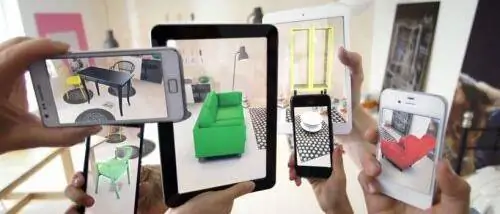Augmented reality (AR) refers to the computer-assisted enhancement of human perception of reality. From a technical perspective, the real and virtual worlds merge together. The advantage: Using cameras, sensors, and high-resolution displays, which are now also found in standard smartphones, virtual aspects (text modules, additional information as images, videos) can be superimposed on real situations for the user. In intralogistics, AR is used, for example, in the Pick-by-Vision picking method, in which AR information is provided via data glasses.
The first attempts to provide users with visual information in addition to the real world were made by electrical engineer Ivan Sutherland in 1968. He developed a type of data glasses, which, however, had to be connected to a computer that took up a lot of space at the time. The glasses projected simple digital patterns onto the wearer’s eye. At the time, development of the technology was slow, partly because there were no practical applications. This changed in the 1990s when Tom Caudell and David Mizell introduced one of the first commercial augmented reality applications for Boeing.
Augmented reality is now used in many areas. Solutions from gaming, navigation, and tourism (city tours) are good examples of best practice, designed primarily for the general public.
Intralogistics, production, service
Whether intralogistics, production or technical service: more and more augmented reality applications are now integrated into industrial processes. The challenge here is that in the world of consumer electronics, picking up a smartphone or tablet is no obstacle. In industrial environments, however, both hands are needed for the work at hand, which is one reason why more and more companies are turning to specialised and, above all, robust data glasses. These are usually controlled via gestures, swipes, and voice commands. In addition, the data glasses are connected to a smartphone via Bluetooth.
Areas of application for augmented reality
- Production
- Intralogistics
- Inventory management
- Training and continuing education
- E-commerce
- Automotive
- Video games
- Sightseeing
- Navigation
AR in intralogistics
Augmented reality is particularly useful in the pick-by-vision method of order picking. During the picking process, the picker receives information via their data glasses (look-around system – see different data glasses in operation) that is crucial for picking: inventory to be picked (name, item number), unique coordinates for the storage location and shelf, quantity to be picked.
Current data glasses, such as those from the manufacturer Vuzix (test), are additionally equipped with a mini scanner module. The user activates this with a gesture, swipe, or voice command, whereupon the scanner automatically scans the user’s field of vision and thus captures a barcode, for example. The data collected in this way can be forwarded directly to the warehouse management system (WMS) or the host via the integrated WLAN module. If the internal warehouse processes and the associated hardware and software allow it, real-time inventory management can be implemented locally. However, this real-time comparison is also possible with classic MDE devices, which also have modern WLAN modules.
Another example is navigation within a distribution center. This allows even untrained personnel to be deployed in a targeted manner. The challenge: Navigation must be implemented via local positioning points. Satellite systems such as GPS can lose accuracy due to structural conditions (metal, wood, concrete) and internal influences (shelves, inventory, liquids). In addition, local coordinates (storage location, storage compartment) cannot be mapped using the GPS system.
Further advantages of AR
- High picking accuracy thanks to self-explanatory visualization; picking errors are automatically reduced.
- Different information can be displayed simultaneously.
- Increased performance by reducing downtime.
Disadvantages
- Older generations struggle with new technology.
- Power supply – a battery pack designed for this purpose must generally be used.
- Glasses wearers require prescription lenses.
- Risk of health impairment with intensive AR use (dizziness, headaches).
- Existing end devices are not always suitable for industrial use.
- Technical functionality: Wi-Fi and Bluetooth can be operated together on the 2.4 gigahertz band. However, this causes interference with Bluetooth transmission. Different frequencies (2.4 and 5 gigahertz) provide a remedy.
AR data glasses: monocular and binocular
Monocular see-through data glasses
The best-known see-through data glasses are Google Glass from 2014. With these glasses, information is first projected onto a prism (mirror) via a projector integrated into the temple. The prism then transmits the additional AR information to the retina of the eye.
Monocular look-around data glasses
In industry, so-called monocular look-around data glasses are generally used. They are equipped with only one small display (no prism) which shows only the necessary additional information. The right eye perceives the real environment through a conventional viewing glass (the following video also shows an example of the video circuit – see ‘binocular data glasses’).
Binocular data glasses
In addition to monocular systems, binocular data glasses are also used for service and maintenance purposes. With binocular devices, a responsible expert is connected to the glasses via live stream for specific applications, such as remote support. The wearer of such a system can view machine components in detail and follow instructions from the stream.
Summary
The industrial segments of logistics, production, and service are not shying away from AR technology and are increasingly relying on wearables, i.e., devices worn on the body. Data glasses, usually in conjunction with smartphones, smartwatches, or tablets, promise enormous potential. They have been proven to accelerate individual processes and detect system errors more quickly.
When using AR solutions, additional digital information, such as videos, images, and text modules, is projected onto the respective display. This supplementary information enables users to optimize both specific and everyday processes and save time, even remotely.
Further information on the topic of augmented reality can also be found at LogiMAT 2017 (Trends) and Smart Data.
Image source: OyundariZorigtbaatar / CC BY-SA 4.0
